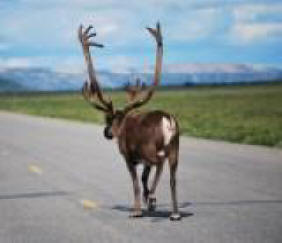|
Ungulates are mammals with hooves, or horny coverings over the lower part of their feet or toes. Ungulates are classified or split into two groups, those with horns and those with antlers. What is the difference between antlers and horns? Antlers grow new each year after being shed or dropped while horns remain in place and continue to grow year to year. Another difference is that with most antlered animals, except for caribou, only the males grow antlers. With horned species, both males and females have horns.
When antlers are growing, they are covered with a soft skin covering called velvet. This covering supplies oxygen and nutrients to the growing bone in the antler. Once the antlers are fully grown, the velvet is lost and the bone dies. Most ungulates shed antlers in the fall or winter and regrow
them in spring or summer.
Alaska’s varied ecosystems, which range from wetlands and forests to tundra, support large numbers of ungulates, as well as a wide variety of species. Ungulates are a common prey species, which means they are often eaten by other animals. Many top predators, including wolves, bears and humans, depend on these hoofed animals for food.
Sitka deer call Alaska home. Did you know deer swallow food and then spit it up to chew all over again? This is called ruminating. Deer, like many ungulates, have
four-chambered stomachs. This digestive system allows deer to eat a lot of food quickly and then chew and digest it later when they are less exposed to danger from predators.
Moose are the largest member of the deer family. Adult moose range in size from 800pounds (small adult female)to 1,600 pounds (large adult male), and they can be up to 6feet tall! Moose range in color from golden brown to almost black. Only male moose grow antlers. Most male calves develop a hair-covered, bony knob by the end of summer that lasts through their first year. Antlers are then grown new each summer and shed each winter throughout a bull’s life.
Caribou live in the arctic tundra, mountain tundra and northern forests of Alaska. There are 32 herds and approximately 900,000 wild caribou in Alaska (compare that to only about 700,000people)!Caribou calving areas, where baby caribou are born, are usually located in the mountains or on open coastal tundra. In the early summer, after calves are born, caribou gather together in large aggregations
Elk share many similarities with moose, deer and caribou. They are usually smaller than moose and larger than deer or caribou. Bulls (the males) stand about five feet tall at the shoulder; cows (the females)are about six inches shorter. The legs and neck of elk are usually darker in color than their body. Elk also have a distinctive light beige or yellow patch on their rump.
Dall sheep live in the mountain regions of Alaska where there is rocky terrain and steep, inclined land. The mountain setting is an ideal place for them to rest and feed. They are occasionally seen below their usual high elevation only when food is scarce. Alaska contains a good size population of Dall sheep. In their rocky environment, they are able to avoid predators and human activities.
Mountain goats are found in the rough and rocky mountain regions of Alaska, throughout the Southeast and along the Coastal Mountains of the Cook Inlet. Populations are generally confined in the areas of the Chugach and Wrangell Mountains. Mountain goats have been transplanted to the islands of Baranof and Kodiak, where they have maintained a steady population. The mountain goat is the only representation in North America of the goat-like ungulates. They constantly migrate to different areas from the alpine ridges in the summer, and to the tree-line in the winter.
American bison were introduced to Alaska in 1928. In 2003, there were approximately 900 wild American bison in Alaska. Their numbers are controlled by managed sport hunting, as predation is not common. Bison can occasionally be seen on their summer range from the Richardson Highway south of Delta Junction, on the Delta Junction Bison range and on the Delta Agricultural Project. Another sub-species of bison, the wood bison was once present in Alaska but is no longer. There are plans to reintroduce wood bison to Alaska in the near future.
|








